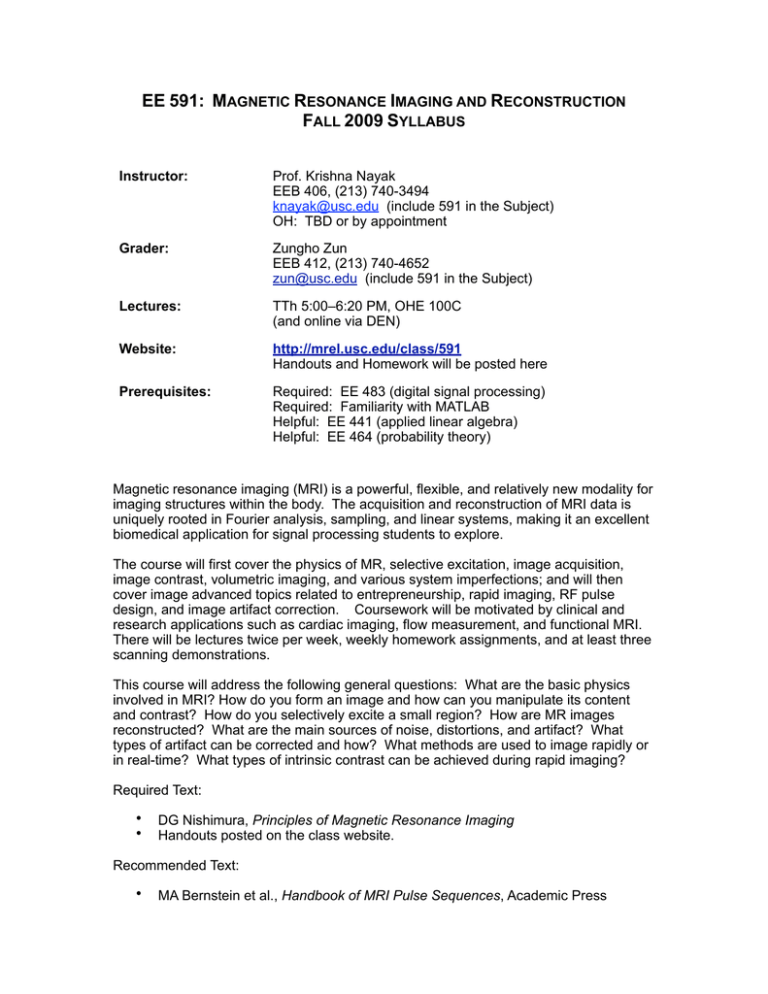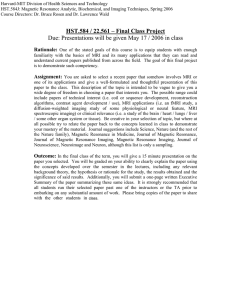EE 591: M
advertisement

EE 591: MAGNETIC RESONANCE IMAGING AND RECONSTRUCTION FALL 2009 SYLLABUS Instructor: Prof. Krishna Nayak EEB 406, (213) 740-3494 knayak@usc.edu (include 591 in the Subject) OH: TBD or by appointment Grader: Zungho Zun EEB 412, (213) 740-4652 zun@usc.edu (include 591 in the Subject) Lectures: TTh 5:00–6:20 PM, OHE 100C (and online via DEN) Website: http://mrel.usc.edu/class/591 Handouts and Homework will be posted here Prerequisites: Required: EE 483 (digital signal processing) Required: Familiarity with MATLAB Helpful: EE 441 (applied linear algebra) Helpful: EE 464 (probability theory) Magnetic resonance imaging (MRI) is a powerful, flexible, and relatively new modality for imaging structures within the body. The acquisition and reconstruction of MRI data is uniquely rooted in Fourier analysis, sampling, and linear systems, making it an excellent biomedical application for signal processing students to explore. The course will first cover the physics of MR, selective excitation, image acquisition, image contrast, volumetric imaging, and various system imperfections; and will then cover image advanced topics related to entrepreneurship, rapid imaging, RF pulse design, and image artifact correction. Coursework will be motivated by clinical and research applications such as cardiac imaging, flow measurement, and functional MRI. There will be lectures twice per week, weekly homework assignments, and at least three scanning demonstrations. This course will address the following general questions: What are the basic physics involved in MRI? How do you form an image and how can you manipulate its content and contrast? How do you selectively excite a small region? How are MR images reconstructed? What are the main sources of noise, distortions, and artifact? What types of artifact can be corrected and how? What methods are used to image rapidly or in real-time? What types of intrinsic contrast can be achieved during rapid imaging? Required Text: • • DG Nishimura, Principles of Magnetic Resonance Imaging Handouts posted on the class website. Recommended Text: • MA Bernstein et al., Handbook of MRI Pulse Sequences, Academic Press Additional References: • • • ZP Liang and PC Lauterbur, Principles of Magnetic Resonance Imaging: a Signal Processing Perspective, Wiley-IEEE EM Haacke et al., Magnetic Resonance Imaging: Physical Principles and Sequence Design, Wiley RN Bracewell, The Fourier Transform and it’s Applications, McGraw Hill Software: • • MATLABTM Mathworks, Inc., South Natick, MA SpinBenchTM http://www.spinbench.com/ (Mac OSX only) Grading (tentative): • • Homework Exams 60% 40% SUGGESTIONS Our primary interest is that you learn as much as possible about signals and linear systems, that you find the material interesting, and that you finish the course wanting to know more about this subject. There are a few important things you can do: (i) ask questions, (ii) actively respond to questions posed in class, (iii) make use of office hours, (iv) don’t sit in the back of the classroom, (v) read about applications of the course material (at the library, on the Internet), (vi) learn to use MATLAB and SpinBench, (vii) remember that exams, grades, and degrees are a means to an end and not an end in itself. STUDENTS WITH DISABILITIES: Any student requesting academic accommodations based on a disability is required to register with Disability Services and Programs (DSP) each semester. A letter of verification for approved accommodations can be obtained from DSP. Please be sure the letter is delivered to me (or to TA) as early in the semester as possible. DSP is located in STU 301 and is open 8:30 a.m. – 5:00 p.m., Monday through Friday. The phone number for DSP is (213) 740-0776. TIMELINE: IMAGING PHYSICS AND ACQUISITION (WEEKS 1-9) HOMEWORKS AND EXAMS Classical description of NMR “spins” Polarization, precession, relaxation and the Bloch Equation Magnetic fields used in MRI k-space Selective Excitation (small-tip approximation) Pulse sequence design, resolution and field of view MIDTERM #1 Thursday, September 17th, in class Bloch Simulation in MATLAB and SpinBench Basic Image Reconstruction Image Contrast based on tissue relaxation properties Imaging Considerations: Flow and Motion; System Imperfections Noise in MRI MIDTERM #2 Thursday, October 22th, in class RAPID IMAGING & ADVANCED TOPICS (WEEKS 10-15) HOMEWORKS ONLY (BUT MORE INVOLVED ONES) Innovation and Entrepreneurship in MRI Parallel Imaging Reconstruction Non-Cartesian k-space reconstruction Constrained and Model-based Reconstruction Partial k-space reconstruction Fat-Water separation Spoiled Gradient Echo Imaging Steady-State Free Precession Imaging Excitation k-space, 2D pulses, spectral-spatial pulses Shinnar-LeRoux RF pulse design Adiabatic RF pulses (NO FINAL EXAM)






